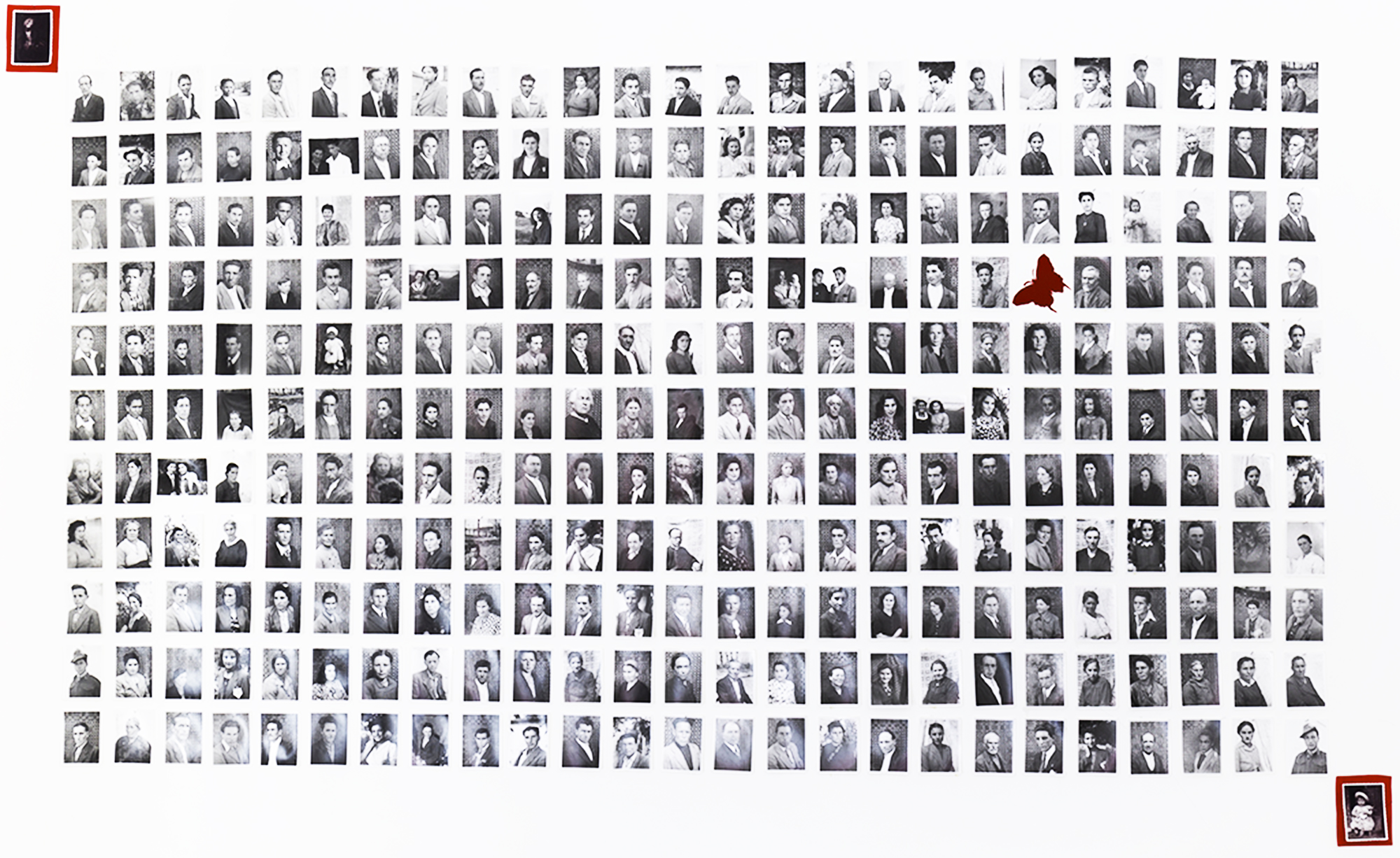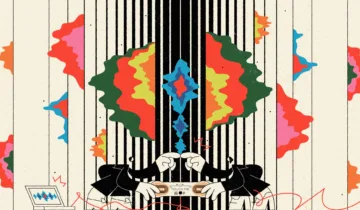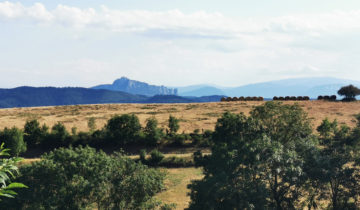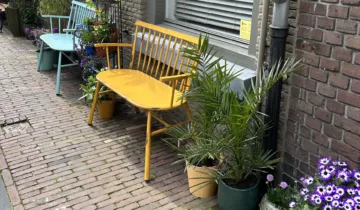We want to present you the artist, Lea Contestabile, from Italy. With her joy and curiosity she bring bright spirit to us. We love her richness of details in her work. Let’s start here with her 🙂
Where were you born and raised?
I was born in Ortucchio (AQ), a small town in Abruzzo. I studied in Cesena (FO), L’Aquila, Rome. I have lived in L’Aquila for many years.
When and how did you get into art?
I have always loved art since I was a child. After high school I enrolled in the Faculty of Architecture in Rome which I attended for a year. However, I wanted to devote myself more to the visual arts and so I enrolled at the Academy of Fine Arts in L’Aquila.
What has been your career path to where you are now? After the Academy of Fine Arts I won a scholarship from the Academy of San Luca, directed by the great Mino Maccari. The scholarship allowed me to work for two years at the National Chalcography directed by Carlo Bertelli. In Chalcography I was able to experiment with chalcographic techniques with the artists Guido Strazza and Giulia Napoleone. Back in L’Aquila, I immediately entered the Academy first as a teacher of Visual Perception and Psychology of Form and then of Artistic Anatomy. I taught at the Academy for forty years, also coordinating the training courses for art teachers for which I also taught Pedagogy and Didactics of Art, Scientific Illustration and Anatomy of the Image. As an Erasmus coordinator, I had the opportunity to attend other European art universities, knowing and collaborating with foreign artists. Even if teaching at the Academy required passion, dedication and time, my artistic activity has never stopped. Thanks to competent and attentive critics, despite living in the province, I had the opportunity to be invited to major exhibitions in Italy and abroad. They believed in my research and supported my work by also curating my personal exhibitions. My artistic activity is documented by exhibitions in Italy (L’Aquila, Rome, Milan, Naples, Florence, Sulmona, Termoli, Forlì, Ascoli Piceno, Pescara, Teramo, Pieve di Cento, San Martino di Castrozza, Spoleto, Enna, Frascati , Ravenna …) and abroad (Latin America, Neuchatel, Hamilton, Rottweil, Toronto, Budapest, Craiova, Calafat, Moscow, Istanbul, Bilbao, Madrid, Bodrum, Paris, Tangier, Iasi, Zagreb …). Among the latest exhibitions I like to remember “Atelier” at the Macro-Museum of contemporary art Rome, “Elements of amorous cosmography”, in Rome at the House of Memory and History in 2019 and in Zagreb at the Italian Cultural Institute in 2020. In the 2011 I was invited to the Venice Biennale and in 2013 and 2017 to the Bodrum Biennale in Turkey. I make art books, videos and shows collaborating with writers and musicians. I like to organize demonstrations and events aimed at building a world of sounds, words, images, colors and movements. Among the last ones I remember the two shows within the Cantieri dell’Immaginario “The liquid rainbow of creativity” with the Solists of L’Aquila and “I quipus della memoria” with the Teatro Stabile and the MUNDA – National Museum of Abruzzo in L’Aquila. My works can be found in various private and public collections and in national and international art museums.
In your view, where do you get your inspiration?
Memory is at the heart of all my work. Mine is an autobiographical work; I love to understand who I am and where I come from. My family and my hometown Ortucchio, a farming village that saw me grow up, are the source of inspiration for my research. The theme of the country and the house has always fascinated me, becoming more and more an identity metaphor after the earthquake that tragically struck my city. Each house is a universe that passes on the memory of grandparents, fathers, children through the many objects: it is a place of affection, of memories, of games, of traditions but also of conflicts and important desires in the construction of the identity of each we.
My work is a continuous “Exercise of memory” with which I sew and unpick a puzzle to make it resurface by re-narrating legends, emotions and passages of my story linked to collective history; I recover fragments of time to regain their meaning, resemantise my Self and build the future time. The garden is also a recurring theme in my work. Mine is a garden of memory, a hortus conclusus in which I can travel to the depths of my interiority and reflect to build an intimate space “all for me”, where I can find my thoughts, my dreams, my affections, my fantasies and, why not, also my nightmares to be exorcised and translated into a positive one. My garden can be made of paper, ceramic, cloth and embroidery, coarse and precious sewing; objects of all kinds coexist in an apparent disorder, pets, fantastic figures and figures from my personal history taken from photos of my family, most often taken by my father and reprinted and reworked by me. It is a sort of “symbolic alphabet”, a personal writing where signs and images are repeated, drawing and organizing ever-changing stories that open holes towards home, towards that peasant civilization of legends told in front of the fireplace during the long winter evenings. It is a “garden of delights”, “locus amoenus”, a place for experimentation and play, where you can test yourself to reconnect forgotten parts of yourself, where you can seek harmony through the joy of “doing” and manipulating different materials. It is the space of introspective listening in which to grasp the inner resonances and get lost through the enchantment and, in a sort of prodigy, find oneself. Like Alice, I like to imagine a surreal and magical world, fantastic and real at the same time where past, present and future can coexist. In the garden of my heart, I stitch together moments from my childhood, the games, the places, the memories of the people who loved me and who helped me grow and become who I am. Tile after tile, like a sort of mosaic, I try to put together the pieces of my memories quilted and re-knotted with flowers, birds, butterflies, hearts and some mazzamurello, a frightening character who made our days of mysterious and magical children. Well-defined spaces alternate with empty spaces, making my works places to move, stop, travel far and wide to find something forgotten or something new that makes you think, giving you the opportunity to tell a little about yourself. It is precisely the need for narration that leads me to build many small stories to be mended in a personal universe. Fabrics, paper, velvet, mesh, ribbons, threads alternate in the construction of my puzzle. The tarlatan painted in black, a material that I have used so much in chalcography, helps me to create the right screen to veil and hide the underlying figures only in appearance. It is memory that makes us see and not see and that, at times, brings to mind events that never really happened, but dreamed and / or hoped for.
What do you want to express with your collages?
Talking about your own work for an artist is never easy because on the one hand you need to distance yourself to reflect objectively on your research and on the other try to get naked to give authentic and profound expression to what you have created.
Often you work driven by an inner urgency that does not make you pause to ask yourself what are the reasons that drive you to look for forms, materials, solutions; it is the work itself that opens the way to paths that you had not thought of but only intuited, moved by the need to do, to tell, to be there.
Mine is however a journey to reopen “the door of the house”, thaw that tortuous labyrinth that is memory and peer into it to snatch its secrets and magic.
It is not nostalgia that guides me in this “NOSTOS”, but the need to bring to light a reality to be investigated and understood.
The installation remains the most congenial and adherent to my work. It allows me to “tame” the space and personalize it according to my way of being, it allows me to build “a room of my own”, a place in which to rediscover the condition of original purity of creation and to devote myself to reflection and meditation in solitude.
I often insert and elaborate in my work the photographs taken by my father, a “farmer-photographer” who, after learned the techniques of photography when he was a soldier in the African war, continued to photograph until the early 1960s, becoming, through his images, the only witness to the memory of the country: weddings, births, deaths, religious celebrations, family portraits. Ties, very important for me, which are reconstructed in the works that I presented in the exhibition “Elements of amorous cosmography” conceived together with Manuela De Leonardis.
Would I like to know more about your latest work of love cosmogony?
The exhibition “Elements of loving cosmography”, documented by an art book published by the Textus publishing house, is conceived as a large family tree whose roots are well planted in the Abruzzo region. The exhibition stitches up the memory of moments in Italian history of the twentieth century through my personal story. And Ortucchio (L’Aquila), my hometown is the starting point for exploring different aspects of Italian history starting from the Second World War. The exhibition takes place in three distinct moments – the memory of the territory, personal memory and historical memory – through the use of embroidery, photography and glues. A memory in which the personal approach, through the analysis of key figures such as my father Guido and my uncle don Odo, my father’s brother, is closely linked and shared with the community’s heritage. In particular, my uncle Don Odo, who spent most of his life in the abbey of Santa Maria del Monte in Cesena, rescued the Jewish families of the Lehrer and Mondolfo, accompanying them across the Swiss border. A street in the city of Cesena was named after him, a theatrical performance was dedicated and, in 2012, a conference at the Palazzo del Ridotto in Cesena in which his request for inclusion in the list of “Righteous among the nations” was advocated.
“The emotional ties of an entire community are told in the works on display; in the installation The country of crossed destinies of 2017, in the work of 2018 The map, the place, the families # 2, in which she embroiders the surnames of the families of the country on the linen of the towels of her wedding trousseau. In Untitled (2015), the photo is a self-portrait of the father while the reproduction of the same image, made in crochet, is the work of the mother. A transversal reading of the society that passes through the portraits of the brides in My father stared at an emotion, I would like to give you back a smile (2017), in which the faces of these brides who never smile are printed on tarlatan, sewn and joined together from safety pins, giving shape to the geography of unexplored and affected feelings to be revealed “.1
Finally, in Carrying a Single Suitcase (2018), I take up a passage from my uncle’s typescript in which he talks about the recommendation that the smugglers made to the Lehrer family to minimize their luggage. On display there are also other works and documentary materials (photographs, brochures, drawings, letters, cameras built directly by my father).
All your work tells about stories from us women, why do you think its important to talk about it in 2020.
There are moments in the life of each of us that irremediably change our way of thinking and perceiving reality. These are events that confront us with questions regarding the meaning of life: our points of view change, the keys to understanding we use to understand ourselves, the world and others move on the scale of values.
For me this moment can be traced back to experiences marked by the encounter with death. The fear of death understood as absence, as silence and waste of time has influenced my entire artistic career since the early nineties.
The loss of my father earlier, and a series of serious health problems not just mine, have put me in the grave possibility of losing everything.
Until then, I had painted in an abstract way. Now there was the desire to anchor my research to life, to experience and to sink more and more feet into the earth, in the traditions of my peasant culture, in that simple world of the countryside, made up of little things that I only appreciated over time . There was a need to tell my story combined with that of the villagers and especially of the women who had been part of my training. As a girl, I couldn’t wait to free myself from that world. The country with its traditions, its rituals was tight on me. Today My desire is to bring back to life, in some way, what I hated and lost. I am driven by the urgent and urgent desire to secure a world whose memory is being lost.
This need for AUTHENTICITY and NARRATION obviously imposed the search for new expressive modes.
The teaching of Artistic Anatomy at the Academy of Fine Arts then forced me to confront myself with phenomena of contemporary art such as Body Art. Artists such as Gina Pane, Louise Bourgeois, Sophie Calle and others have placed me in front of themes and artistic modalities that required the challenge of getting involved with all of their experiences. Thus, over time, the feminine dimension has become more and more central and my gaze has focused on expressive and communicative practices, even of the artisanal ones (sewing, crochet, crochet, embroidery) of women.
4 In recent years, my research entitled “and I’ll take care of you… KINTSUGI or the crack enhancement technique” has focused on the body in its various meanings.
The research was born from the desire to somehow exorcise the fear of illness and to tell how the wound can become an instrument of rebirth and reconstruction. Conceived not only in a physical sense, the body, the fulcrum of the processes of building personal and collective female identity, has proved to be a privileged territory on which scars dig deep, creating the opportunity to experience suffering as a gift to get to know each other better; pain brings one’s self back to reality, becomes testimony of a real experience, and art acts as a means to tell and better define the image of this suffering.
The body, memory and personal guardian is also a symbolic and collective ritual force par excellence, a vehicle of traditions, social relationships, conventions.
The emotional fragility of the works and the solidarity with the female world found a correspondence in the choice of materials used and in the techniques of realization: threads, sewing, transparent plastics, cloths woven by women of the country, gauze, plasters … The multi-material works, installations, sculptures and paintings, votive boxes appear as a sort of “sacred” inventions, creative objects with an apotropaic function. The installations are a kind of one large ex-voto, a set of compositions in turn resulting from the union of different elements. The desire was to translate the painful experiences of life into a positive through the metaphors of art and share them with others, in particular with other women.
For us its a special topic but how to you see the future of women on earth, in business and life?
I strongly believe in the ability of women to create beauty, harmony and peace among men. Women have the intelligence and the strength to truly transform the world. Unfortunately, history has taught us that the female gender is frightening and that is why it must be kept under control.
In recent times, I feel, with great apprehension, a sort of return to the battles and conquests obtained in the seventies. On the contrary, I find that the art system that has always obscured and ignored female artists today pays particular attention to the female world and looks at the work of artists with great interest.
Tell us the story behind “your museum for children”
The MuBaq-Museo dei Bambini L’Aquila is a beautiful dream that is coming true.
The idea was born in 1995. In the Academy I taught Pedagogy and Didactics of Art and with my students I went to schools to set up educational workshops. Children are extraordinary, they let themselves be moved by contemporary art more than adults. I understood that art could be a tool capable of educating and training. I realized the great power of creativity, a form of intelligence capable of developing a critical conscience through a personal and autonomous gaze on the world.
I began to cultivate the idea of building a place to experience a different way of bringing children closer to art and in particular to contemporary art.
I studied the method of the great Bruno Munari trying to put his teachings into practice; I created opportunities for meetings in the Academy with personalities from the world of art and education, I invited Beba Restelli, Munari’s assistant to better deepen the didactic-training methodologies.
After the 2009 earthquake thanks to the Municipality of Fossa, donations from the Oliver Twist Foundation, the Soroptimist International and Zonta International Clubs, Henkel Italia SRL, cultural associations, Art Galleries, artists and art supporters and I managed to build the seat of the Museum which is located near the Borgo di San Lorenzo, which was also born after the earthquake.
Over time, the project has been enriched with large site-specific sculptures that make up the Mubaq Park, thus creating what is gradually becoming the CHILDREN’S ART VILLAGE.
With our projects related to contemporary art (we have an excellent international art collection) we create opportunities for cultural growth for the whole area. Our art village is increasingly becoming a place of excellence and tourist attraction also because it is located within an area that sees the prestigious Necropolis of Fossa and Santa Maria ad Cryptas, a jewel of the 9th century AD.
In 2019 in the MuBAQ Park we designed and built, as part of the Restart Call, “The Garden of Memory” dedicated to the many children who died in the earthquake with site-specific works by 12 international artists.
What is your general philosophy?
Be authentic and intellectually honest, have respect for myself and for the other. I believe in the right / duty to be happy and to try to make the people around me happy. I love simplicity and a quiet life even if enriched by travels that introduce me to different people and cultures
What’s your biggest challenge as a artist?
Being able to authentically narrate my world through personal and non-stereotyped expressive methods such as to emotionally involve those who approach my works. My hope is that my work, even if it tells stories, local traditions and peasant identities, can be closely linked to a wider and more qualified contemporary art system.
My hope is that, despite living in the Province, my artistic research does not appear provincial but is profound, personal, innovative. I also hope that my art will continue to exist and excite even when I am no longer there.
Why did you choosed to be in laquila?
I didn’t choose to stay in L’Aquila but L’Aquila chose me. In L’Aquila I found work, teaching at the Academy and love, my husband.
What’s your favorite spot in laquila?
My house, my studio, the MuBaq. I know I am self-referential but this is my world of love, dreams, art where I love to live.
How do you spend your days off?
I have a few days off. When it happens I love being with friends but especially with my family, especially with my two grandchildren. I love traveling very much.
What would people be surprised to know about you?
I have no idea. I think I appear confident and determined. I’m actually shy; my humble origins, of which I am very proud today and which I exalt in my work, created many ensembles at the beginning of my artistic career that made me make many mistakes and made me miss many important trains.
If you weren’t, making art and teaching art for a living, what would you be doing?
I love theater (as a child I used to play small shows with other children; director, first actress, set designer, screenwriter, costume designer, I wanted to do everything myself). I love fashion very much, I would have loved to be a fashion stylist, just as I would have liked to be an interior designer or hairdresser.
How do you define success?
I can’t define it. I think it means having acknowledgments from professionals, museums, gallery owners, critics at great levels. As far as I’m concerned, success also means being able to work with peace of mind with critics and gallery owners who respect you and appreciate your work regardless of financial results.
About what should we be more conscious?
In general I think the most important thing for me is to be aware that all men are different but with equal rights. Accept diversity as a wealth and try to put yourself in the other person’s shoes.
As far as art is concerned, I think that an artist must be honest in expressing his world, however, by connecting it to contemporary research in order not to repeat what has already been done but on the contrary to seek new formal and content paths.
How do you think the world can be a better place?
The world could be better if man finally decided to have more respect and love than the other man (for the weakest, the poorest and for women), more respect for animals and the environment. The world could be better if we decided not to end our actions and our behavior on the God of money. The world would be better if Politicians and Heads of State finally returned to POLITICS and to deal with the common good and not with the personal good. This would certainly lead to the end of wars by building a truly democratic world of peace without disparity and without dictatorships. The world would certainly be better if FREEDOM were a good for all and above all defended by all.
What is your life motto?
If you love yourself, you also do well to others. In life, a little bit of healthy selfishness is good for you and for others.
Do you want to share something with us, you ever wanted to say, and never had the possibility?
I want to reiterate that, despite my husband’s and my health problems, I consider myself a lucky person. Life has been kind to me. I had a simple but happy childhood in a family that protected me and instilled values that still guide me today. I was close to a man who loved me dearly and deeply and who has always supported me in my work. I couldn’t have a better son than Francesco who gave me two wonderful grandchildren.
I do the job I dreamed of doing. It is a privilege that few can afford.
The teaching, which at first created problems for me, has revealed itself over time, an experience that has made me grow artistically and humanly.
Even today I have contacts with some of my former students who also help me in the activities of the MuBAQ.
Dear Lea, thank you for your time and having us!
Here you can visit the website of Leas Museum





 No products in the cart.
No products in the cart.